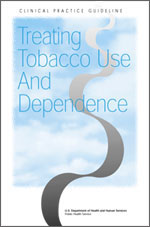Clinical Practice Guideline
 Public Health Service Guideline In Action
Public Health Service Guideline In Action
Clinical Opportunities and Teachable Moments
Lori Pbert, PhD
Associate Professor of Medicine
University of Massachusetts Medical School
Physicians in the clinical practice setting are in a unique position to identify tobacco users and to provide effective intervention.
- First, as a physician you provide accessible and continuous care to your patients. Your long-term relationship with your patients offers many clinical opportunities and teachable moments to deliver intervention and provide crucial follow-up within the course of routine care.
- Second, you are a credible source of health-related information and assistance.
- Lastly, there is strong evidence from many clinical trials that brief smoking cessation counseling delivered by physicians, dentists, and other clinicians increases smoking cessation rates in their adult patients.
This evidence led to the development of the Clinical Practice Guideline Treating Tobacco Use and Dependence: 2008 Update, produced by the U.S. Public Health Service (see Related Resources below).
| The current guideline recommends that clinicians deliver the 5A intervention. Today, the abbreviated 2As and R Intervention is widely accepted as an effective tobacco use treatment intervention: Ask about tobacco use at every visit, Assist the patient in quitting, and Refer patients to QuitNow-NH through QuitWorks-NH for proactive telephone counseling. |
The literature review, conducted to develop the guideline, concluded that physician advice to quit improved adult cessation rates, and the addition of brief counseling (less than three minutes) was even more effective. Both behavioral counseling (including telephone-based services) and pharmacotherapy (nicotine gum, patch, nasal spray and inhaler, lozenge, or the anti-depressant bupropion known as Zyban® or Wellbutrin SR®) were found to be effective, with a combination of counseling and pharmacotherapy producing the best results.
Because people who use tobacco state that a physician’s advice to quit is a strong motivator to make repeated quit attempts and to maintain abstinence from tobacco use, the impact you can have on your patients’ tobacco use cannot be overestimated.
 Brief Clinician Interventions = 2As and R
Brief Clinician Interventions = 2As and R
Here’s how QuitWorks-NH supports your efforts to integrate the 2As and R intervention as a standard of care in your practice:
ASK About Tobacco Use at Every Visit
Implement an office system that ensures that, for every patient at every visit, tobacco-use status is queried and documented. Call the New Hampshire Department of Health and Human Services, Division of Public Health Services, Tobacco Prevention & Control Program: 1-800852-3345 ext.8949 or email Teresa.Brown@dhhs.nh.gov.
ASSIST Patients who use Tobacco in Quitting
- Provide brief counseling: “I strongly advise you to quit smoking, and I can help you.”
- Recommend use of pharmacotherapy (patch, gum, nasal spray, inhaler, bupropion-SR, varenicline) unless contraindicated.
REFER Patients to a Quit Coach Through QuitWorks-NH
- QuitWorks-NH provides clinicians with FDA recommendations for pharmacotherapy dosing.*
- Enroll patients in QuitNow-NH services through QuitWorks’NH’s simple referral form and a QuitWorks-NH “Welcome Guide” enrollment pamphlet.
*Inclusion of an adult dosage chart is strictly for the convenience of the prescribing provider. Please consult the Physicians’ Desk Reference for complete product information and contraindications. The chart does not indicate or authorize insurance benefit coverage for any of these medications. For insurance benefit information, the patient will need to contact his/her insurer directly. The cost or provision of these medications is not included as any part of the NH Tobacco Helpline.
 Gold Standard “5A’s” Intervention in Action
Gold Standard “5A’s” Intervention in Action
Watch a 5-minute video entitled “Basic Skills for Working with a person who uses tobacco: The Brief 5A Intervention”.
 Systematic Identification of person who uses tobacco
Systematic Identification of person who uses tobacco
Adopting office systems to identify a person who uses tobacco and to prompt providers to intervene increases the delivery of tobacco use treatment by clinicians. For information on systems change, call the New Hampshire Department of Health and Human Services, Division of Public Health Services, Tobacco Prevention & Control Program at 1-800-852-3345 ext.8949 or email Teresa.Brown@dhhs.nh.gov.
 Behavioral Counseling and Pharmacotherapy
Behavioral Counseling and Pharmacotherapy
Behavioral counseling (including telephone-based services) and pharmacotherapy (nicotine gum, patch, nasal spray, lozenge, and inhaler), the antidepressant bupropion (Zyban® or Wellbutrin SR®), or the nicotine receptor agonist varenicline (Chantix™) were found to be effective. A combination of counseling and pharmacotherapy produced the best results. Physician or clinician advice based on health issues provides a strong incentive for a person who uses tobacco to quit. QuitWorks-NH reinforces and enhances clinician efforts and supports successful quit attempts.
 Telephone Counseling Works
Telephone Counseling Works
The Public Health Service Clinical Practice Guideline recommends telephone counseling, as treatments involving person-to-person contact (individual, group, or telephone counseling) are consistently effective.
| RELATED RESOURCES Treating Tobacco Use and Dependence: 2008 Update – Clinical Practice Guideline. This Guideline is an updated version of the 2000 Treating Tobacco Use and Dependence Guideline. It is the product of a private-sector panel of experts, consortium representatives, and staff. The update was written to include new, effective clinical treatments for tobacco dependence that have become available since the 2000 Guideline was published. The 275-page Guideline contains strategies and recommendations designed to assist clinicians; tobacco dependence treatment specialists; and health care administrators, insurers, and purchasers in delivering and supporting effective treatments for tobacco use and dependence. |
Refer Your Patients to a Quit Coach
Submit a Provider Web Referral or E-Referral through the EMR.
Choose the most convenient method for YOUR practice!
